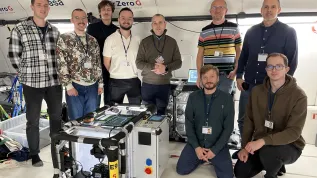
Scientists from Krakow and Wrocław are investigating how lichens cope in Mars-like conditions—and early results suggest they could survive there.
Kaja Skubała, PhD, a professor at the Jagiellonian University (JU) and lead of the National Science Centre-funded project Life on the Edge – A Step Toward Identifying Lichen Adaptations to Extreme Extraterrestrial Conditions, told the Polish Press Agency (PAP) that in the future, these organisms could help protect humans from harmful radiation.
Lichens are symbiotic organisms made up of fungi and photosynthetic partners, usually algae or cyanobacteria. Skubała said they first caught her attention during her studies.
“As part of my master's thesis, I conducted research on smelter dumps in Upper Silesia. I observed that in that environment, heavily contaminated with heavy metals such as lead, zinc, arsenic, and cadmium, lichens thrive,” she said.

Skubała later began researching lichen resilience in extraterrestrial environments, focusing on Mars, where the atmosphere is 95% carbon dioxide, temperatures range from -140°C to 20°C, and the surface is exposed to high doses of solar and ionising radiation.
“However, these studies focused on desiccated lichens, i.e., ones in a state of anhydrobiosis,” Skubała said. “I was interested in hydrated organisms. I wanted to test whether, when water is present in fungal hyphae and algal cells, meaning the organisms are metabolically active, they will be able to function and survive in conditions similar to those on Mars.”

The team simulated Martian conditions in the laboratories of the Department of Solar Physics at the Space Research Centre of the Polish Academy of Sciences in Wrocław. Lichens were placed in a vacuum chamber with controlled gas mixtures, pressure, temperature, humidity, and simulated solar and ionising radiation.
“Determining whether this amount [of water vapour] is sufficient for lichens to maintain a metabolically active state for an extended period is a matter of future research,” Skubała said.
The results suggest potential applications for protecting humans from ionising radiation in space.
“We have demonstrated that one species of lichen, Diploschistes muscorum, is able to defend itself against this radiation even in its hydrated form,” Skubała said.

Skubała also highlighted the possibility of using lichens as protective biocoatings in space habitats: “On Earth, fungi extract sugars from algae in lichens, but they obtain oxygen from the atmosphere,” she said. “We are wondering whether a new dimension of lichen symbiosis is possible, in which fungi and algae create a self-sufficient organism. From the perspective of extraterrestrial life, this would be a very important discovery.”
Research under the Life on the Edge project will continue until at least 2027. Initial findings have been published in IMA Fungus.
Future experiments aim to explore whether lichen symbionts can produce oxygen for respiration in Martian-like conditions.
Anna Bugajska (PAP)
abu/ bar/ mow/ kap/
tr. RL













